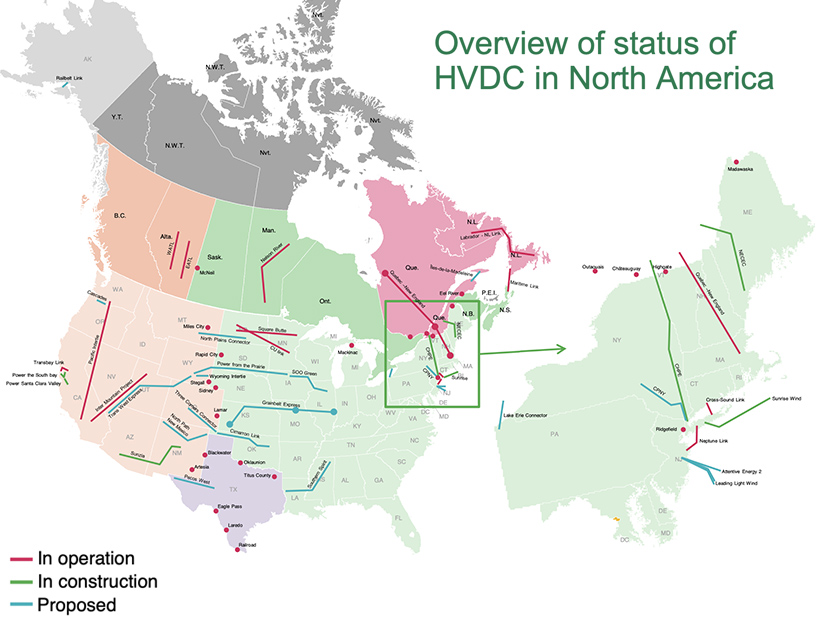HVDC transmission lines can help efficiently connect offshore wind power, meet growing demand onshore and link together the balkanized grid, but before their use can be expanded in the U.S., the OSW industry needs to set some standards, according to a joint company survey.
DNV’s HVDC Standards joint industry project (JIP), which finished its first phase in April, was convened to identify deficiencies in standards for HVDC. DNV worked with Atlantic Shores Offshore Wind, EDF Renewables, Equinor, Invenergy, National Grid Ventures, Ocean Winds, PPL TransLink, WindGrid, RWE, Shell and TotalEnergies.
The firm launches JIPs when a need crops up in the industries it covers for firms to come together and work on a common issue. While HVDC lines have been growing in the U.S., the domestic industry and regulators still lack key standards to deal with how the technology impacts the grid, DNV Principal Consultant Morgan Putnam said in an interview.
“If you look at Europe, there’s a lot of work that’s been done over the last decade to think through the various ways that an HVDC transmission system can operate and the various services that it can provide to the grid,” Putnam said. “And in order to be able to enable those services, you have to define certain aspects of what the system will and will not do, so that you understand how it will impact the rest of the grid. … We really haven’t thought through that for the North American grid.”
The AC backbone of the grid has been in place for over a century, so the country has not had to look at basic standards for it in generations, he added.
Putnam said the JIP’s work is expanding to a “much larger effort” with the Department of Energy, National Renewable Energy Laboratory, RTOs, utilities and others. DOE will be funding a study process that lasts several years to identify gaps in standards, come up with a plan to fill them, and then implement that plan and remove barriers to wider use of HVDC.
High-voltage lines operate much better underground or underwater than AC transmission, and the technology offers efficiencies for long-haul overhead lines. Their power density is also higher than AC, meaning more power can flow over less actual infrastructure, DNV Principal Consultant Cornelis Plet said in the interview.
The JIP has identified 25 different standards that need to be defined, including active power control, reactive power control, power recovery requirements, emergency power control and islanded operation.
The standards include issues at the national, regional and local levels. The developers that DNV worked with on the first phase came up with five areas that they want to see addressed the most: offshore design standards, performance standards, reliability standards, ISO/RTO manuals and utility interconnection manuals.
“As we are looking at substantially more HVDC projects going forward, in order to have a more efficient process, we really do want to standardize these 25 functional requirements,” Putnam said. “And, so, what we’ve looked at is in the U.S., there’s about 10 of them where there’s some partial standardization, and then there’s 15 that there’s not any coverage at all.”
Even the partially completed standards include plenty of work because they often address just one of the three to four likely use cases of HVDC transmission, he added.
Getting all the standards in place in the U.S. will require working with multiple agencies that oversee different aspects of the industry, compared to Europe where one grid code offers some standardization even across different countries, Plet said.
“There are a number of different hierarchical organizations that create rules that transmission providers have to adhere to,” Plet said. FERC sets very high-level technical principles; he noted that last year it mandated HVDC as part of the transmission planning process. NERC sets the minimum technical standards for reliability, but Plet noted that many of their rules for HVDC are designed for overhead lines and need updates for subsea and buried cables.
Regional reliability entities have their role to play, as do ISOs and RTOs, which have to come up with ways to handle the technology in their interconnection and operational requirements.
“This is where developers of HVDC links often run into problems because ISOs often don’t know how to treat an HVDC line,” Plet said. “There’s no specific class for it. Is it a generator? Not really, but it sometimes behaves a little bit like one. Is it a transmission line? Also not really, but it does have some of the transmission line functions. So how [do you] distinguish between that and … create some clear connection requirements for HVDC systems that are not conflicting on both ends of the line? … And this includes not only how should it be studied, but also how can it participate in the different power markets.”
One hot topic has been whether an HVDC line designed to ship power from one region to another can participate in the capacity market on the delivery end, he added.
State regulators also have a role to play in that they are ultimately responsible for ensuring that consumers do not pay too much for energy, Plet said. The New Jersey Board of Public Utilities and New York Public Service Commission have mandated the use of HVDC lines for the offshore wind those states have procured, he noted.
Getting the standardization in place is a key hurdle to making HVDC a normal part of system planners’ toolbox; Plet argued that the technology will be vital to expanding the transmission system.
“You need HVDC,” Plet said. “You will not be able to build out enough new transmission capacity without it.”



